In today’s digital landscape, where attention spans are shorter than ever and competition for eyeballs is fierce, creating immersive content has become the secret weapon that separates successful brands from the forgotten ones. If you’re still relying on static images and basic videos to tell your story, you’re essentially showing up to a Formula 1 race with a bicycle.
The multimedia revolution is here, and 360-degree technology is leading the charge. Whether you’re a developer implementing WebXR experiences, a technical content creator working with spatial audio pipelines, or a business owner wanting to leverage volumetric capture technology, understanding the technical foundations of immersive multimedia experiences can literally make or break your digital presence.
Table of Contents
Technical Foundations of Creating Immersive Content
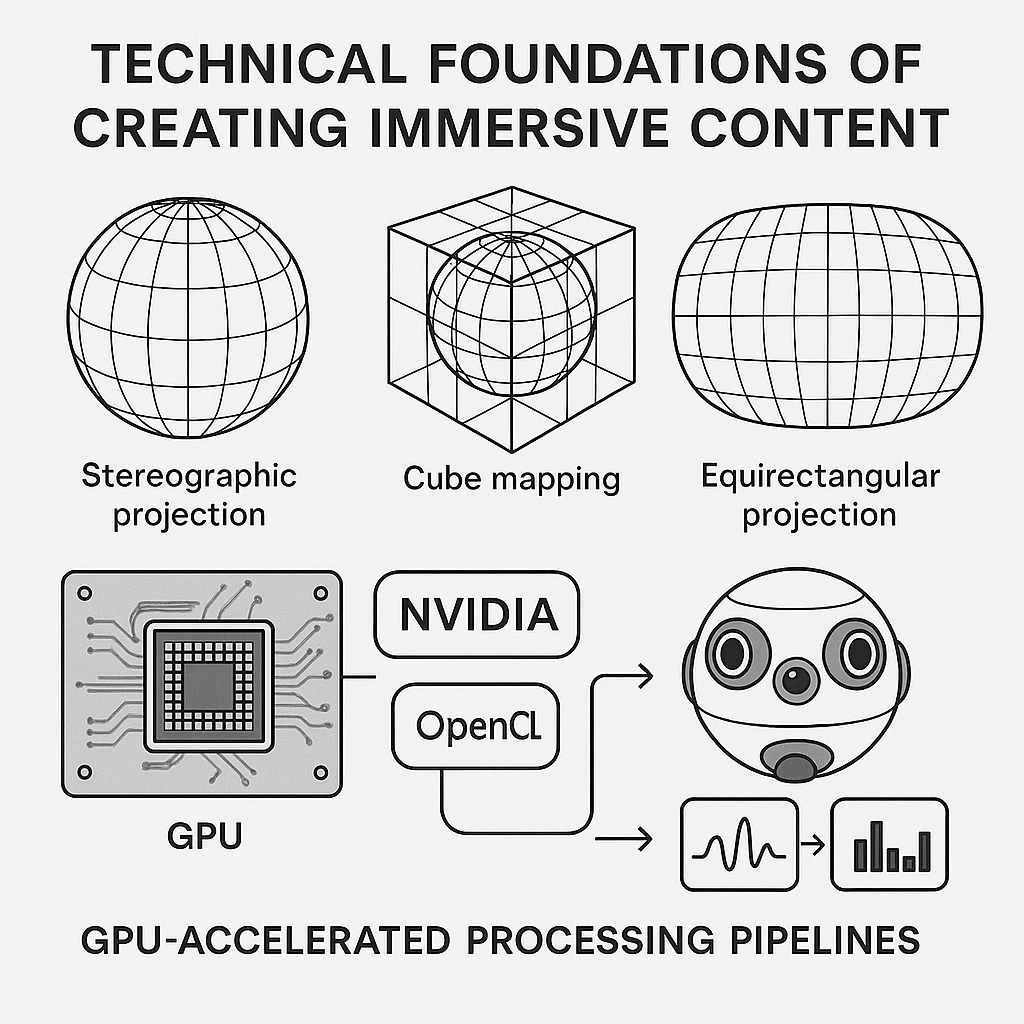
Creating immersive content requires a deep understanding of spherical projection mathematics, equirectangular mapping, and real-time rendering pipelines. Unlike traditional media that operates on flat planes, 360-degree content must account for spherical coordinate systems where every pixel represents a direction vector in 3D space.
The fundamental challenge lies in converting spherical imagery into formats that can be processed by conventional computing systems. This involves complex mathematical transformations including stereographic projection, cube mapping, and equirectangular projection. These projection methods each have different distortion characteristics and computational requirements that affect both quality and performance.
Modern 360-degree content creation relies heavily on GPU-accelerated processing pipelines. NVIDIA’s CUDA cores and OpenCL frameworks enable real-time stitching and rendering of high-resolution spherical content. The parallel processing capabilities of modern graphics cards are essential for handling the massive computational overhead of multi-camera synchronization and real-time spatial audio processing.
Advanced Camera Systems and Capture Technologies
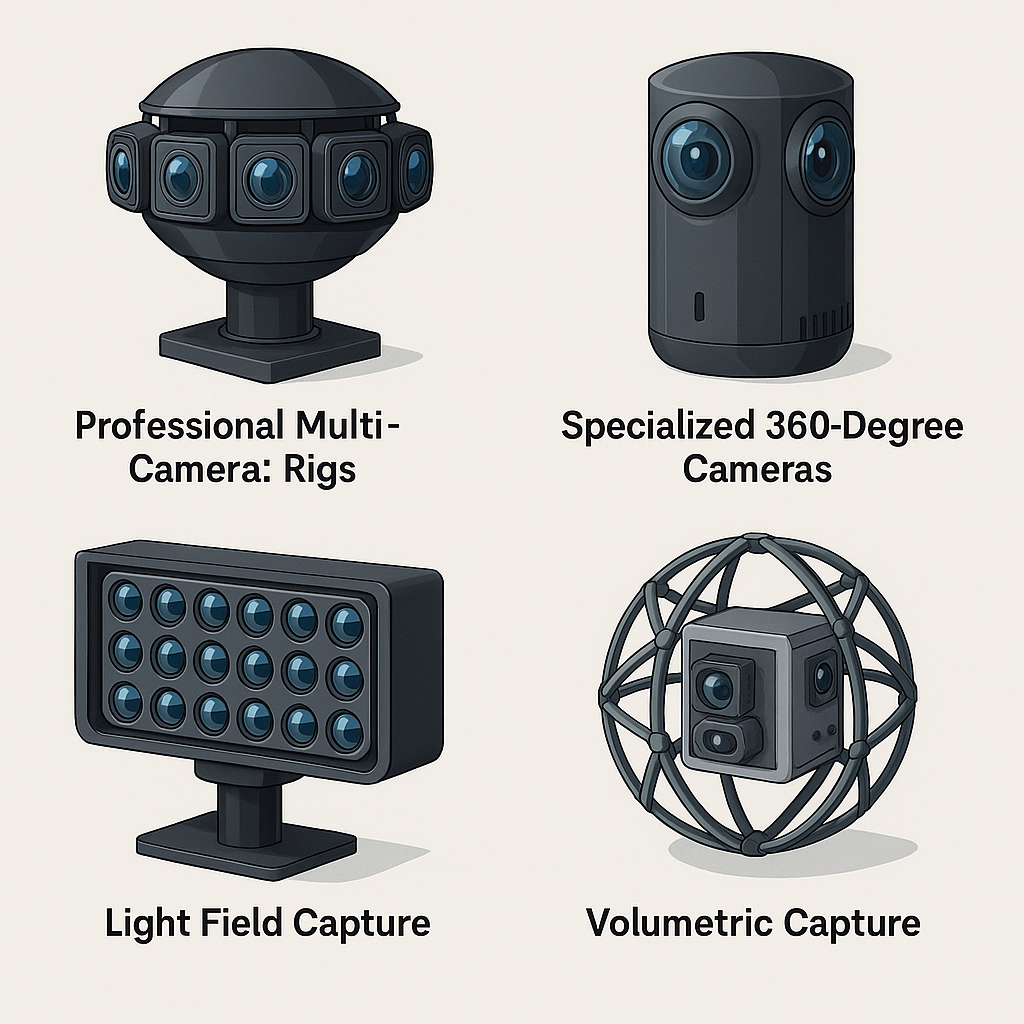
Professional Multi-Camera Rigs
Professional 360-degree capture systems utilize arrays of synchronized cameras with precise calibration matrices. The Z CAM V1 Pro employs six 4K cameras with custom-designed fisheye lenses that capture overlapping fields of view. Each camera’s intrinsic and extrinsic parameters must be precisely calibrated using sophisticated algorithms like Zhang’s calibration method or bundle adjustment optimization.
The GoPro Omni rig represents another approach, using eight GoPro HERO cameras arranged in a cubic formation. This system requires frame-accurate synchronization achieved through genlock signals and timecode generators. The overlapping regions between cameras are processed using computer vision algorithms like SIFT (Scale-Invariant Feature Transform) or ORB (Oriented FAST and Rotated BRIEF) feature detection for seamless stitching.
Specialized 360-Degree Cameras
Consumer-grade 360-degree cameras like the Insta360 Pro 2 incorporate multiple sensors with specialized fisheye lenses. These cameras use real-time image processing units (IPUs) that perform on-device stitching using proprietary algorithms. The camera’s firmware implements complex lens distortion correction using Brown-Conrady models and applies dynamic calibration based on environmental conditions.
The Kandao QooCam 8K utilizes dual 200-degree fisheye lenses with 1/1.7″ CMOS sensors. Its processing pipeline includes real-time HDR (High Dynamic Range) capture, spatial stabilization using gyroscopic data, and hardware-accelerated H.265 encoding. The camera’s custom silicon processes up to 8K resolution at 30fps using dedicated video processing units.
Light Field and Volumetric Capture
Advanced immersive content creation now incorporates light field cameras and volumetric capture systems. The Lytro Immerge camera array captures not just directional information but also light field data, enabling post-production focus adjustments and depth-based effects. This technology uses plenoptic sampling theory to capture the complete light field within a spherical volume.
Intel’s True VR system represents the cutting edge of volumetric capture, using arrays of RGB-D cameras (like Intel RealSense) to capture both color and depth information. The system employs advanced mesh reconstruction algorithms, including Poisson reconstruction and marching cubes, to create detailed 3D models from multi-view stereo data.
Spatial Audio Technologies and 3D Sound Processing
Ambisonics and Spatial Audio Encoding
True immersive experiences require sophisticated spatial audio processing. First-order ambisonics (FOA) captures 3D audio using four-channel encoding (W, X, Y, Z) that represents sound pressure and particle velocity in three dimensions. Higher-order ambisonics (HOA) provides increased spatial resolution using spherical harmonics up to the seventh order.
The Zoom H3-VR recorder utilizes a tetrahedral microphone array with built-in ambisonic encoding. Its processing pipeline includes real-time spherical harmonic decomposition, noise reduction algorithms, and format conversion between A-format (raw tetrahedral) and B-format (encoded ambisonics).
Binaural Audio Processing
For headphone-based experiences, binaural audio processing converts spatial audio to convincing 3D sound. Head-Related Transfer Functions (HRTFs) simulate how sound reaches each ear from different directions. The processing involves convolution with impulse responses measured from dummy heads or computed using acoustic modeling.
Facebook’s Spatial Workstation and Google’s Resonance Audio SDK provide comprehensive binaural processing engines. These systems implement advanced algorithms including room impulse response simulation, distance-based attenuation modeling, and dynamic range compression optimized for VR applications.
Real-Time Rendering and Graphics Pipeline
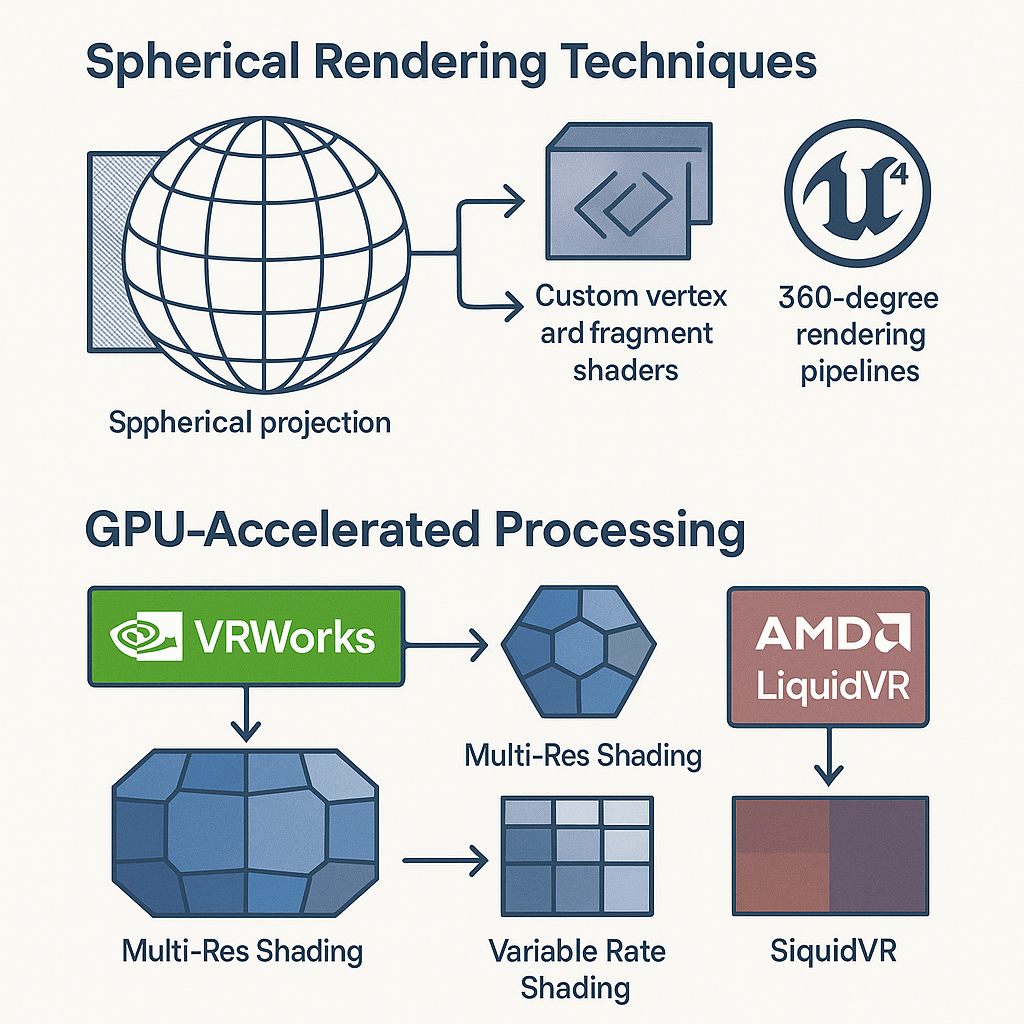
Spherical Rendering Techniques
Rendering 360-degree content requires specialized graphics pipelines that account for spherical projection. Traditional rasterization pipelines must be modified to handle equirectangular texture mapping and spherical coordinate transformations. This involves custom vertex and fragment shaders that perform real-time coordinate space conversions.
Modern graphics engines like Unity 3D and Unreal Engine 4 incorporate specialized 360-degree rendering pipelines. Unity’s XR Toolkit provides optimized rendering paths for different VR headsets, including foveated rendering that reduces computational load by rendering lower detail in peripheral vision areas.
GPU-Accelerated Processing
NVIDIA’s VRWorks SDK provides GPU-accelerated algorithms specifically designed for VR content creation. The Multi-Res Shading technology renders different regions of the 360-degree view at varying resolutions, optimizing performance while maintaining visual quality. Variable Rate Shading (VRS) further reduces computational overhead by selectively reducing shading rates in less important areas.
AMD’s LiquidVR technology offers similar optimizations with Asynchronous Shaders and Advanced Sync capabilities. These technologies minimize motion-to-photon latency, which is crucial for preventing motion sickness in immersive experiences.
Advanced Stitching Algorithms and Computer Vision
Feature Detection and Matching
Professional 360-degree content creation relies on sophisticated computer vision algorithms for seamless stitching. SIFT and SURF algorithms detect distinctive features in overlapping regions between cameras. These features are then matched using techniques like RANSAC (Random Sample Consensus) to eliminate outliers and establish correspondence between images.
The PTGui software implements advanced stitching algorithms including control point optimization, geometric correction, and exposure blending. Its processing pipeline uses Bundle Adjustment optimization to minimize reprojection errors across all camera views simultaneously.
Optical Flow and Motion Estimation
For video stitching, optical flow algorithms track pixel motion between frames to maintain temporal consistency. The Lucas-Kanade method and Horn-Schunck algorithms are commonly used for dense motion estimation. These calculations require significant computational resources, often utilizing GPU acceleration through CUDA or OpenCL implementations.
Adobe’s After Effects uses proprietary optical flow algorithms in its VR Comp Editor, while specialized software like Vahana VR and Autopano Video Pro implement optimized motion estimation specifically for 360-degree content.
Compression and Streaming Technologies
Specialized Video Codecs
360-degree video requires specialized compression techniques that account for spherical projection distortions. The H.265/HEVC codec includes projection-aware encoding that optimizes bitrate allocation based on viewing probability. Tiles-based encoding divides the spherical image into segments, allowing adaptive streaming based on user viewing direction.
Facebook’s Transform360 project provides open-source tools for optimal 360-degree video encoding. The system implements pyramid projection and offset cubic projection methods that reduce bandwidth requirements while maintaining visual quality in likely viewing areas.
Adaptive Bitrate Streaming
Streaming 360-degree content requires sophisticated adaptive bitrate algorithms. Unlike traditional video, 360-degree streams must predict user viewing behavior to pre-cache appropriate quality levels. Machine learning algorithms analyze head movement patterns to anticipate which portions of the spherical video will be viewed next.
YouTube’s 360-degree streaming infrastructure uses prediction algorithms combined with viewport-adaptive streaming. The system maintains multiple quality levels for different regions of the spherical video, dynamically adjusting based on user behavior and network conditions.
WebXR and Browser-Based Technologies
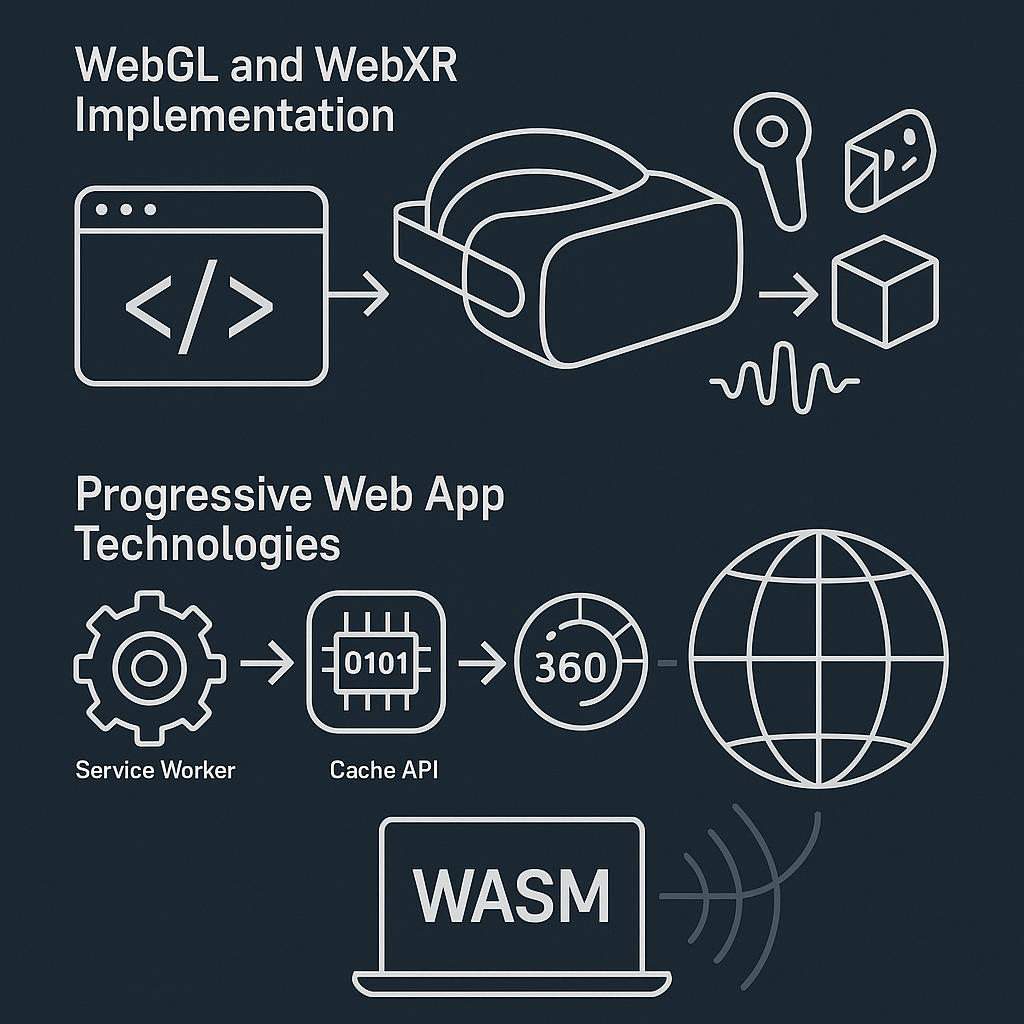
WebGL and WebXR Implementation
Browser-based 360-degree experiences utilize WebGL for hardware-accelerated rendering and WebXR APIs for device integration. The WebXR Device API provides standardized access to VR headsets, motion controllers, and spatial tracking systems. Implementation requires careful management of rendering loops, projection matrices, and coordinate space transformations.
Three.js and A-Frame frameworks simplify WebXR development by providing high-level abstractions for 360-degree content creation. These frameworks handle complex shader management, geometry processing, and cross-platform compatibility automatically.
Progressive Web App Technologies
Modern immersive web experiences utilize Service Workers for offline caching of 360-degree content. The Cache API enables intelligent pre-loading of spherical textures and audio files. Web Assembly (WASM) provides near-native performance for computationally intensive operations like real-time stitching and spatial audio processing.
Content Management and Distribution Platforms
Specialized CMS Solutions
Professional 360-degree content management requires specialized platforms that handle spherical metadata, projection formats, and multi-resolution assets. Koncept VR provides enterprise-grade content management with automated transcoding, metadata extraction, and distribution across multiple platforms.
The system implements automated quality assurance algorithms that detect stitching artifacts, exposure inconsistencies, and audio synchronization issues. Machine learning models trained on thousands of 360-degree videos automatically flag potential quality problems before publication.
CDN and Edge Computing
Delivering 360-degree content requires sophisticated Content Delivery Networks optimized for large file sizes and adaptive streaming. Amazon CloudFront and Microsoft Azure CDN provide specialized 360-degree video delivery with edge caching strategies that account for spherical projection characteristics.
Edge computing nodes perform real-time transcoding and projection format conversion, enabling optimal delivery to different devices and platforms. This reduces latency and bandwidth requirements while maintaining visual quality.
Emerging Technologies and Future Developments
Artificial Intelligence and Machine Learning
AI-powered tools are revolutionizing 360-degree content creation. NVIDIA’s Maxine SDK uses deep learning for real-time video enhancement, including super-resolution, noise reduction, and artifact removal specifically designed for spherical content. These algorithms are trained on massive datasets of 360-degree imagery to understand the unique characteristics of immersive media.
Machine learning models now handle complex tasks like automatic object removal, seamless stitching, and intelligent exposure blending. Adobe’s Sensei AI platform includes specialized algorithms for 360-degree content that can automatically identify and correct common issues like nadir patching and zenith distortion.
Volumetric Video and Neural Radiance Fields
Neural Radiance Fields (NeRFs) represent the cutting edge of volumetric content creation. These AI models can generate photorealistic 3D scenes from limited 2D inputs, enabling creation of immersive experiences from conventional photography. The technology combines deep learning with computer graphics to synthesize novel viewpoints with unprecedented realism.
Google’s Immersive Light Fields project demonstrates how machine learning can create convincing volumetric experiences from sparse camera arrays. The system uses neural networks to interpolate between camera positions, generating smooth motion parallax and realistic lighting effects.
Quality Assurance and Testing Frameworks
Automated Testing Systems
Professional 360-degree content production requires sophisticated quality assurance systems. Automated testing frameworks analyze stitching quality using computer vision metrics like structural similarity index (SSIM) and peak signal-to-noise ratio (PSNR). These systems detect artifacts including ghosting, exposure mismatches, and temporal inconsistencies.
The Immersive Media Testing Suite provides comprehensive automated testing for 360-degree content. The system includes specialized algorithms for detecting motion sickness triggers, audio synchronization issues, and platform-specific compatibility problems.
Performance Optimization Tools
Profiling tools specifically designed for 360-degree content help optimize performance across different platforms. Unity’s XR Profiler provides detailed metrics on rendering performance, GPU utilization, and thermal management. These tools are essential for ensuring smooth playback on mobile devices and standalone VR headsets.
NVIDIA’s Nsight Graphics offers advanced profiling capabilities for VR applications, including frame timing analysis, shader performance optimization, and memory usage tracking. The tool provides specific recommendations for improving 360-degree content performance on different GPU architectures.
Technical Implementation Challenges
Synchronization and Timing
Multi-camera 360-degree systems require precise synchronization to avoid temporal artifacts. Hardware solutions like Tentacle Sync generators provide frame-accurate timing using genlock signals. Software solutions implement timestamp-based synchronization with sub-frame accuracy using interpolation algorithms.
The challenge intensifies with wireless camera systems where network latency introduces timing variations. Advanced synchronization algorithms use predictive models to compensate for network delays and maintain temporal coherence across all camera feeds.
Thermal Management and Power Consumption
High-resolution 360-degree capture generates significant heat and power consumption. Professional systems implement active cooling solutions and power management algorithms that balance performance with thermal constraints. The cameras’ firmware includes thermal throttling mechanisms that automatically reduce processing load when temperatures exceed safe limits.
Mobile 360-degree cameras face additional challenges with battery life and heat dissipation. Specialized algorithms optimize processing pipelines to minimize power consumption while maintaining quality. This includes intelligent scene analysis that adjusts processing intensity based on content complexity.
Data Pipeline and Workflow Management
Automated Processing Pipelines
Professional 360-degree content production utilizes automated processing pipelines that handle ingestion, processing, and distribution. These systems implement complex workflows using tools like Apache Airflow or custom solutions built with containerized microservices.
The pipeline includes automated quality checks, metadata extraction, transcoding to multiple formats, and distribution to various platforms. Machine learning models optimize processing parameters based on content characteristics, ensuring optimal quality while minimizing processing time.
Cloud-Based Processing Solutions
Cloud platforms provide scalable processing capabilities for 360-degree content. Amazon Web Services offers specialized instances with powerful GPUs for real-time stitching and rendering. Google Cloud Platform provides similar capabilities with TPUs optimized for machine learning workloads.
Microsoft Azure’s Mixed Reality services include cloud-based processing specifically designed for immersive content. These platforms handle complex tasks like volumetric reconstruction, spatial audio processing, and multi-platform transcoding.
Conclusion: The Technical Blueprint for Immersive Content Success
Creating immersive content with 360-degree multimedia demands mastery of four core technical pillars: advanced camera systems with precise calibration, GPU-accelerated processing pipelines, spatial audio technologies, and intelligent compression algorithms. Success hinges on understanding how these components work together to deliver seamless user experiences.
The evolution from basic 360-degree capture to AI-powered volumetric content creation represents a fundamental shift in how we approach immersive media. Technologies like Neural Radiance Fields, real-time stitching algorithms, and adaptive streaming protocols are no longer optional – they’re essential tools for competitive content creation.
Key technical takeaways include implementing proper camera synchronization using genlock signals, leveraging CUDA-accelerated processing for real-time operations, utilizing ambisonic audio for true spatial experiences, and optimizing content delivery through platform-specific encoding strategies.
The future of immersive content lies in automated AI-driven workflows that handle complex technical processes while maintaining creative control. Start with foundational tools like multi-camera rigs and spatial audio systems, then gradually integrate advanced features as your technical expertise develops.
Ready to transform your content strategy? Begin by implementing a basic 360-degree processing pipeline and watch how technical precision amplifies creative vision in ways traditional media simply cannot achieve.
Frequently Asked Questions
What are the minimum system requirements for professional 360-degree content creation?
Professional 360-degree content creation requires powerful hardware configurations. A minimum system should include an Intel Core i7 or AMD Ryzen 7 processor, 32GB RAM, dedicated graphics card with at least 8GB VRAM (NVIDIA RTX 3070 or better), and fast NVMe SSD storage. For real-time processing, NVIDIA RTX 4080 or higher is recommended with CUDA compute capability 7.5 or above.
How do I synchronize multiple cameras for 360-degree capture?
Camera synchronization requires hardware timecode generators or software-based solutions. Professional setups use genlock generators that provide frame-accurate timing signals to all cameras. Software solutions like DaVinci Resolve can synchronize footage using audio waveforms or visual cues, but hardware synchronization provides superior accuracy for seamless stitching.
What’s the difference between equirectangular and cubic projection?
Equirectangular projection maps the entire sphere onto a rectangular image with significant distortion at the poles. Cubic projection divides the sphere into six cube faces, providing more uniform pixel distribution but requiring more complex processing. Each projection method has different storage requirements, processing overhead, and visual characteristics that affect the final viewing experience.
How do I optimize 360-degree content for mobile devices?
Mobile optimization requires careful balance between quality and performance. Use efficient codecs like H.265 with hardware acceleration, implement adaptive bitrate streaming, and consider lower resolution versions for older devices. Optimize graphics shaders for mobile GPUs, reduce polygon counts in 3D scenes, and implement thermal throttling to prevent overheating.
What spatial audio formats are compatible with different VR platforms?
Different platforms support various spatial audio formats. Oculus platforms prefer Facebook 360 Spatial Audio, while Steam VR supports multiple formats including ambisonics and binaural. YouTube 360 accepts ambisonic audio in AmbiX format, while mobile platforms often require binaural conversion for headphone playback. Cross-platform compatibility requires encoding to multiple formats or using adaptive audio solutions.
How do I measure the quality of 360-degree content?
Quality measurement requires specialized metrics beyond traditional video assessment. Use spherical PSNR and SSIM metrics that account for projection distortions. Analyze stitching quality using seam detection algorithms, measure spatial audio accuracy using dummy head recordings, and conduct user studies to assess motion sickness potential and overall user experience.
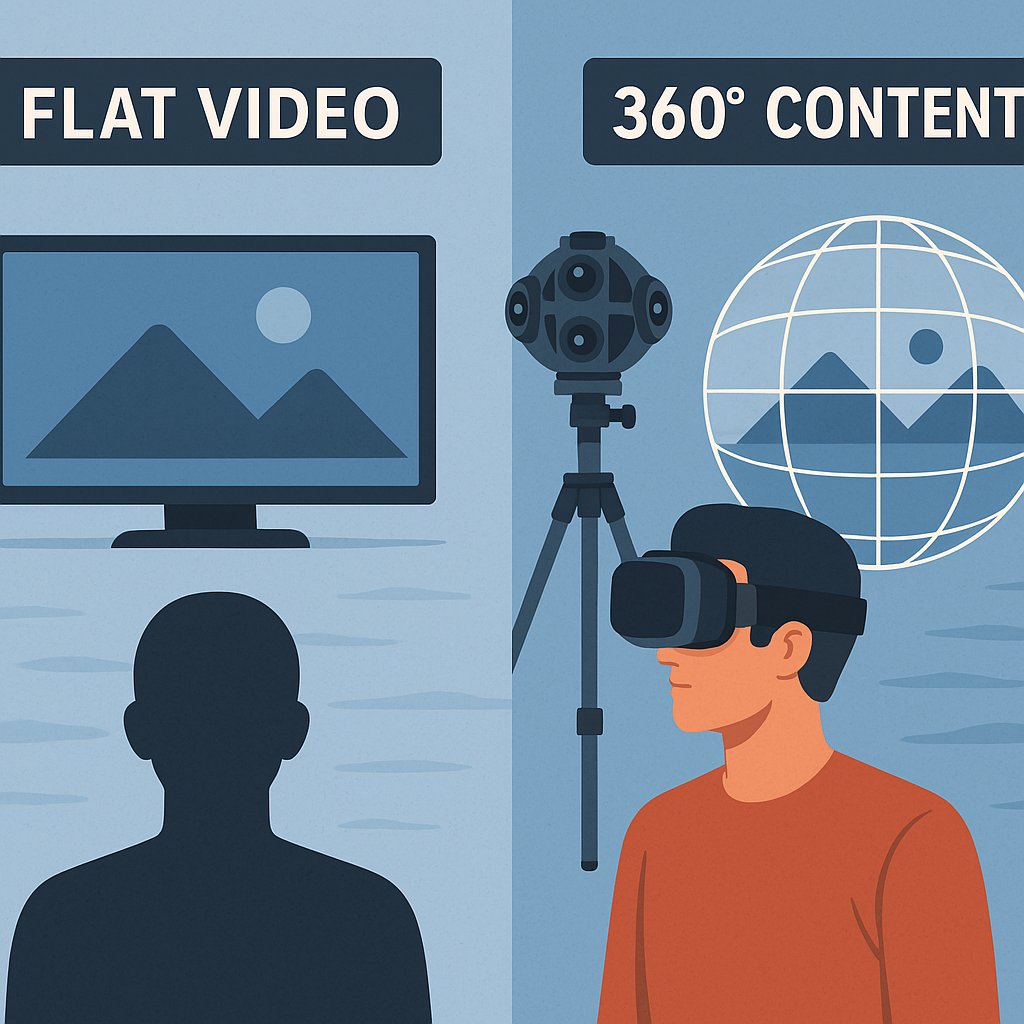
Pingback: Instagram Reels vs Stories: 7 proven Content Strategy Secrets for Maximum Engagement